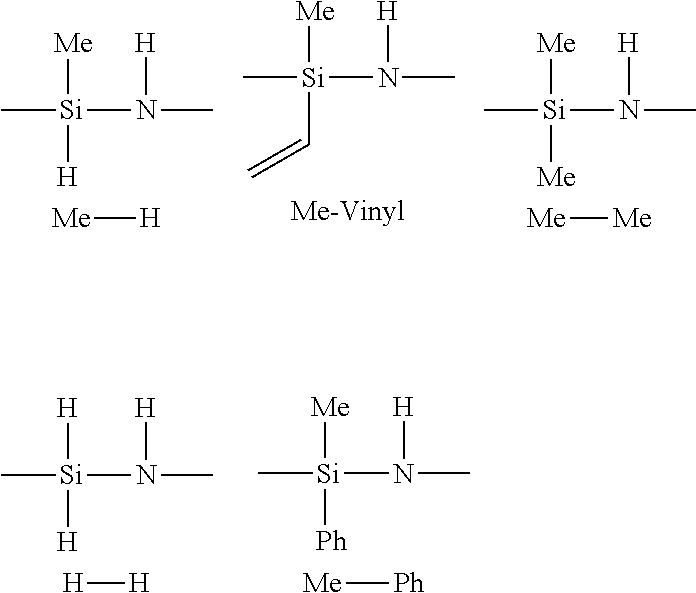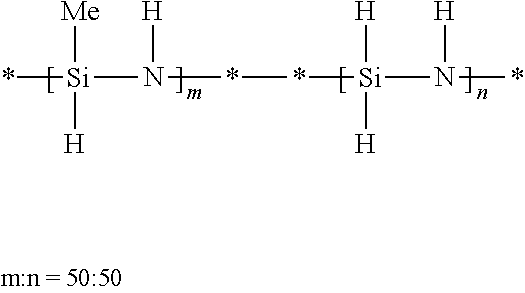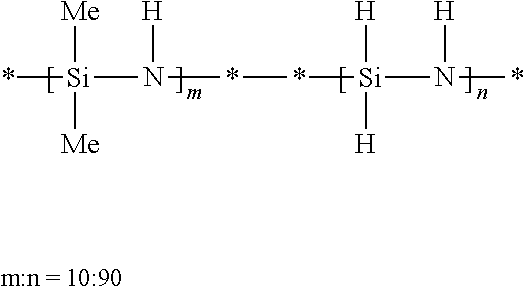Process for preparing shelf-stable curable polysilazanes, and polysilazanes prepared thereby
a technology of polysilazane and polysilazane, which is applied in the field of preparation of compositions containing polysilazane, can solve the problems of affecting the shelf life of the composition, the odor of the composition, and the use of the ceramic material in some applications, and achieves the effects of improving shelf stability, long shelf life, and low initial viscosity
- Summary
- Abstract
- Description
- Claims
- Application Information
AI Technical Summary
Benefits of technology
Problems solved by technology
Method used
Image
Examples
example 3
Preparation of
[0084]
[0085]A 2-liter, three-necked flask equipped with a mechanical stirrer, a dry ice / acetone condenser, and an ammonia inlet tube was charged with hexane (800 mL) and anhydrous pyridine (0.84 mole, 66.4 g, equal to the stoichiometric amount of silicon-chlorine bonds in the dichlorosilane). Dichlorosilane (25 weight percent in xylene, 0.42 mole, 169.7 g) was added dropwise to the flask. White, solid pyridine adduct was produced and precipitated out. The resulting slurry was stirred at room temperature for one hour. Methyldichlorosilane (0.18 mole, 20.7 g) was then added to the slurry, and ammonia was then slowly bubbled into the flask. The temperature of the resulting reaction mixture increased. The reaction continued until 35 g of ammonia had been added. The resulting byproduct salt was filtered off. Evaporation of solvent from the resulting filtrate gave 16.9 g of viscous copolysilazane (yield of 68.7 percent).
example 4
Preparation of
[0086]
[0087]A 3-liter, three-necked flask equipped with a mechanical stirrer, a dry ice / acetone condenser, and an ammonia inlet tube was charged with hexane (1250 mL) and anhydrous pyridine (0.6 mole, 47.5 g, equal to the stoichiometric amount of silicon-chlorine bonds in the dichlorosilane). Dichlorosilane (25 weight percent in xylene, 0.3 mole, 121.2 g) was added dropwise to the flask. White solid pyridine adduct was produced and precipitated out. The resulting slurry was stirred at room temperature for one hour. Methyldichlorosilane (0.5 mole, 57.5 g) and methyl vinyl dichlorosilane (0.2 mole, 28.2 g) were added to the slurry, and then ammonia was slowly bubbled into the flask. The temperature of the resulting reaction mixture increased. The reaction continued until 65 g of ammonia had been added. The resulting byproduct salt was filtered off Evaporation of solvent from the resulting filtrate gave 63 g of viscous copolysilazane.
example 7
Preparation of
[0093]
[0094]A 1-liter, three-necked flask equipped with a mechanical stirrer, a dry ice / acetone condenser, and an ammonia inlet tube was charged with dichlorosilane (25 weight percent in xylene, 0.3 mole, 121.2 g) and 500 mL hexane. Then, trimethylamine (160 g, 2.71 moles) was added to the flask. White solid trimethylamine adduct was produced. After 1 hour, the dry ice / acetone condenser was removed and essentially all unreacted trimethylamine was allowed to evaporate over a period of two hours. Dimethyldichlorosilane (0.03 mole, 3.87 g) was then added to the flask. The resulting slurry was stirred at room temperature for one hour. Ammonia was then slowly bubbled into the flask. The temperature of the resulting reaction mixture increased. The reaction continued until 67 g of ammonia had been added. The resulting byproduct salt was filtered off. Evaporation of solvent (using an oil bath set at 55° C. and 668.7 Pa (0.0066 atmosphere) vacuum) gave 6.8 g of viscous copolysi...
PUM
| Property | Measurement | Unit |
|---|---|---|
| modulus | aaaaa | aaaaa |
| hardness | aaaaa | aaaaa |
| temperature stability | aaaaa | aaaaa |
Abstract
Description
Claims
Application Information
 Login to View More
Login to View More - R&D
- Intellectual Property
- Life Sciences
- Materials
- Tech Scout
- Unparalleled Data Quality
- Higher Quality Content
- 60% Fewer Hallucinations
Browse by: Latest US Patents, China's latest patents, Technical Efficacy Thesaurus, Application Domain, Technology Topic, Popular Technical Reports.
© 2025 PatSnap. All rights reserved.Legal|Privacy policy|Modern Slavery Act Transparency Statement|Sitemap|About US| Contact US: help@patsnap.com



